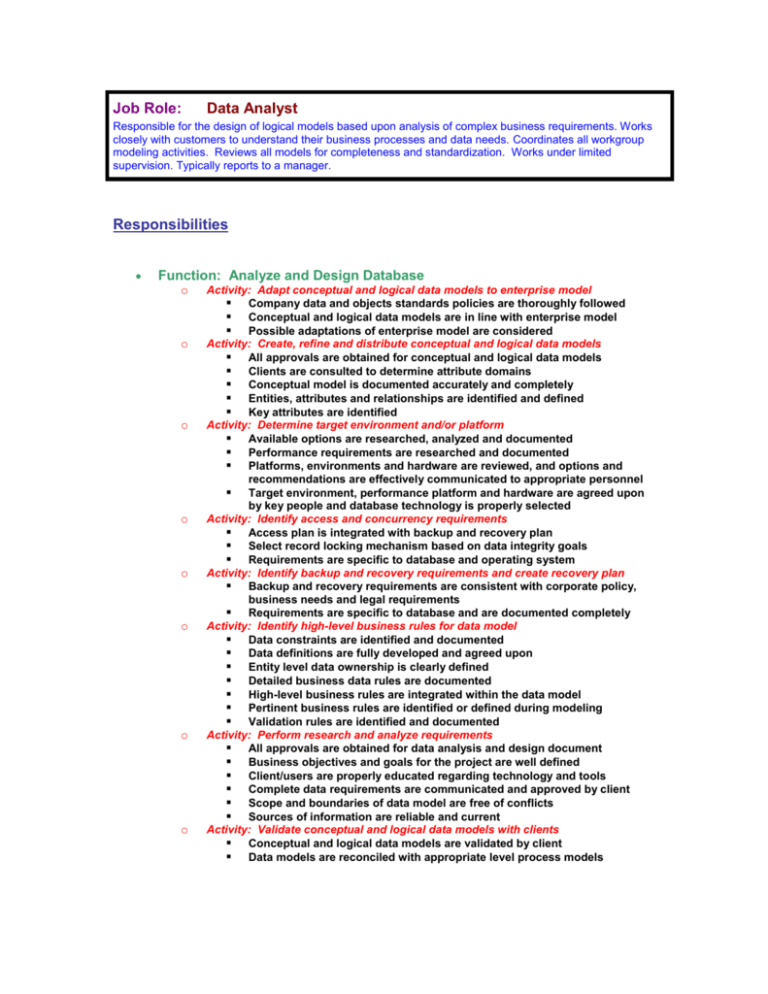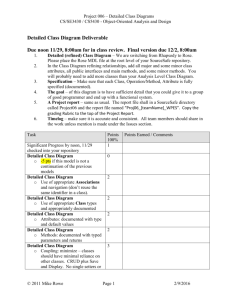Job Role: Data Analyst – Senior Level – Band 4
advertisement

Job Role: Data Analyst Responsible for the design of logical models based upon analysis of complex business requirements. Works closely with customers to understand their business processes and data needs. Coordinates all workgroup modeling activities. Reviews all models for completeness and standardization. Works under limited supervision. Typically reports to a manager. Responsibilities Function: Analyze and Design Database o o o o o o o o Activity: Adapt conceptual and logical data models to enterprise model Company data and objects standards policies are thoroughly followed Conceptual and logical data models are in line with enterprise model Possible adaptations of enterprise model are considered Activity: Create, refine and distribute conceptual and logical data models All approvals are obtained for conceptual and logical data models Clients are consulted to determine attribute domains Conceptual model is documented accurately and completely Entities, attributes and relationships are identified and defined Key attributes are identified Activity: Determine target environment and/or platform Available options are researched, analyzed and documented Performance requirements are researched and documented Platforms, environments and hardware are reviewed, and options and recommendations are effectively communicated to appropriate personnel Target environment, performance platform and hardware are agreed upon by key people and database technology is properly selected Activity: Identify access and concurrency requirements Access plan is integrated with backup and recovery plan Select record locking mechanism based on data integrity goals Requirements are specific to database and operating system Activity: Identify backup and recovery requirements and create recovery plan Backup and recovery requirements are consistent with corporate policy, business needs and legal requirements Requirements are specific to database and are documented completely Activity: Identify high-level business rules for data model Data constraints are identified and documented Data definitions are fully developed and agreed upon Entity level data ownership is clearly defined Detailed business data rules are documented High-level business rules are integrated within the data model Pertinent business rules are identified or defined during modeling Validation rules are identified and documented Activity: Perform research and analyze requirements All approvals are obtained for data analysis and design document Business objectives and goals for the project are well defined Client/users are properly educated regarding technology and tools Complete data requirements are communicated and approved by client Scope and boundaries of data model are free of conflicts Sources of information are reliable and current Activity: Validate conceptual and logical data models with clients Conceptual and logical data models are validated by client Data models are reconciled with appropriate level process models o o Function: Provide Data Assurance o Activity: Integrate high-level business rules with code Data constraints required by the organization are implemented Database triggers, objects, and procedures are documented business rules are examined with impact on database determined Referential integrity and check constraints are enforced Activity: Select unique identifiers and normalize the data model Define attributes of entities, primary natural keys and relationships Data model is in third normal form Logical and data models are validated by the client Logical model is validated against all transactions Activity: Gather and document security requirements Security requirements are documented Potential security risks are identified and resolved Function: Coordinate and Review o o Activity: Coordinate all modeling activities in workgroup Plan resource needs for upcoming projects Work with management to assign projects Follow up with sponsors on project progress Activity: Review all models for consistency Review models for consistency across company Provide feedback to other data analyst on improvement opportunities Skills Category: Business Concepts and Practices o o o o Category: Cognitive o o o o Conscientious Flexible and adaptable Category: Specific Databases o Encryption Firewalls (e.g., Network Address Translation, NAT) Password practices and procedures Category: Organizational o o Data warehousing Distributed databases and processing On-line transaction processing Relational databases Category: Network Security o o o Bachelor's Degree in Technical discipline Category: Database Processing o o o o Creation of forms and reports Data flow and data structure modeling Data management including modification, replication, clustering, and optimization Data warehousing and data mining Database concepts including tables, data types, instances, fields, and rows Database security including access control, back-up and recovery Query languages for database management system (e.g., SQL and PL/SQL) Specific Database Management System Data Definition Language (DDL) Specific Database Management System Data Manipulation Language (DML) Category: Education o Methods for trend analysis including forecasting system resources and space usage Category: Databases o o o o o o o o o Backup and recovery techniques Code and scripts to move data between systems Data conversion techniques Legal requirements for archiving data Techniques for data validation during and after conversion Techniques to map data between old system and new one Category: Database Performance Management o Concurrency constraints within a system and across systems Data cleaning, updating, editing and validation techniques Data privacy rules, laws, and implementation techniques Data storage and access within government regulation, and corporate policies Developing database triggers, foreign key constraints, and validation (code) tables User access rights to individual tables, rows, and columns (e.g., DDL SQL) Category: Data Management, Backup and Recovery o o o o o o Analytical thinker Detail oriented Healthy skeptic Independent thinker Category: Data Management o o o o o o Business principles and business and industry-specific terminology Business case analysis Costing, budgeting, risk and financial analysis Quality assurance concepts and procedures Varies by site (e.g. DB2, Oracle, Access, Microsoft SQL Server) Category: Specific Operating Systems o o o Others may be required for specific sites (e.g. Unix, OS400) Others would be useful (e.g. MVS, Linux, Mac OS, Sun OS) Windows Category: Tools for Data Management o o RDBMS Catalog tools (e.g., Control Center, BMC Catalog Manager, Enterprise Manager) Metadata tools (e.g. ERWin, Bachman, Oracle Designer) Category: Work Experience o o o o 10+ years experience in the field or a related area preferred Works well with little to no supervision Takes initiative Self starter





